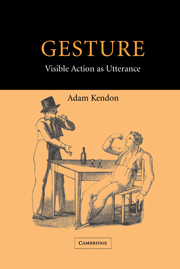Book contents
- Frontmatter
- Contents
- Acknowledgments
- 1 The domain of gesture
- 2 Visible action as gesture
- 3 Western interest in gesture from Classical Antiquity to the eighteenth century
- 4 Four contributions from the nineteenth century: Andrea de Jorio, Edward Tylor, Garrick Mallery and Wilhelm Wundt
- 5 Gesture studies in the twentieth century: recession and return
- 6 Classifying gestures
- 7 Gesture units, gesture phrases and speech
- 8 Deployments of gesture in the utterance
- 9 Gesture and speech in semantic interaction
- 10 Gesture and referential meaning
- 11 On pointing
- 12 Gestures of ‘precision grip’: topic, comment and question markers
- 13 Two gesture families of the open hand
- 14 Gesture without speech: the emergence of kinesic codes
- 15 ‘Gesture’ and ‘sign’ on common ground
- 16 Gesture, culture and the communication economy
- 17 The status of gesture
- Appendix I Transcription conventions
- Appendix II The recordings
- References
- Index
4 - Four contributions from the nineteenth century: Andrea de Jorio, Edward Tylor, Garrick Mallery and Wilhelm Wundt
Published online by Cambridge University Press: 05 February 2015
- Frontmatter
- Contents
- Acknowledgments
- 1 The domain of gesture
- 2 Visible action as gesture
- 3 Western interest in gesture from Classical Antiquity to the eighteenth century
- 4 Four contributions from the nineteenth century: Andrea de Jorio, Edward Tylor, Garrick Mallery and Wilhelm Wundt
- 5 Gesture studies in the twentieth century: recession and return
- 6 Classifying gestures
- 7 Gesture units, gesture phrases and speech
- 8 Deployments of gesture in the utterance
- 9 Gesture and speech in semantic interaction
- 10 Gesture and referential meaning
- 11 On pointing
- 12 Gestures of ‘precision grip’: topic, comment and question markers
- 13 Two gesture families of the open hand
- 14 Gesture without speech: the emergence of kinesic codes
- 15 ‘Gesture’ and ‘sign’ on common ground
- 16 Gesture, culture and the communication economy
- 17 The status of gesture
- Appendix I Transcription conventions
- Appendix II The recordings
- References
- Index
Summary
In the course of the nineteenth century several important works on gesture were published. In this chapter we look at four of these: Andrea de Jorio's treatise on Neapolitan gesture, published in 1832; the treatment of gesture in the work of Edward Tylor, published in 1865; Garrick Mallery's work on gesture inspired by what he had learned of sign languages in use among the Plains Indians of North America, published in 1880; and Wilhelm Wundt's analysis of gesture in relation to the emergence f spoken language, which first appeared in 1901. De Jorio's book is notable both because it is probably the first ethnographic study ever to be published which describes the forms and functions of gesture within a particular community - that of Naples - and also because it is one of the earliest books in which ethnography is used in relation to archaeology. Tylor shows how the study of gesture can throw light on the processes that underlie the development of symbolic communication, whether in gesture, picture-writing or spoken language. Tylor, Mallery and Wundt each make significant advances in the understanding of sign languages, in some respects anticipating discoveries that were not to be made until the second half of the twentieth century. In Mallery's work we not only have detailed observations on sign language as used among the Plains Indians of North America, we also have a wide ranging survey of what was then known of the phenomena of gestural expression in general.
- Type
- Chapter
- Information
- GestureVisible Action as Utterance, pp. 43 - 61Publisher: Cambridge University PressPrint publication year: 2004



